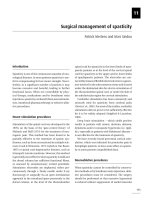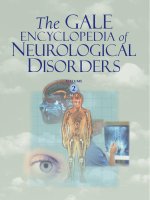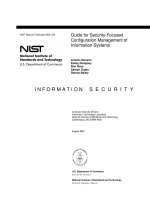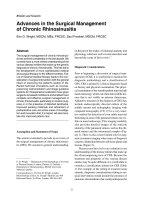Surgical Management of Movement Disorders potx
Bạn đang xem bản rút gọn của tài liệu. Xem và tải ngay bản đầy đủ của tài liệu tại đây (2.54 MB, 351 trang )
Surgical
Management
of Movement
Disorders
NDT_half-series-title 6/24/05 12:31 PM Page A
NEUROLOGICAL DISEASE AND THERAPY
Advisory Board
Louis R. Caplan, M.D.
Professor of Neurology
Harvard University School of Medicine
Beth Israel Deaconess Medical Center
Boston, Massachusetts
William C. Koller, M.D.
Mount Sinai School of Medicine
New York, New York
John C. Morris, M.D.
Friedman Professor of Neurology
Co-Director, Alzheimer’s Disease Research Center
Washington University School of Medicine
St. Louis, Missouri
Bruce Ransom, M.D., Ph.D.
Warren Magnuson Professor
Chair, Department of Neurology
University of Washington School of Medicine
Seattle, Washington
Kapil Sethi, M.D.
Professor of Neurology
Director, Movement Disorders Program
Medical College of Georgia
Augusta, Georgia
Mark Tuszynski, M.D., Ph.D.
Associate Professor of Neurosciences
Director, Center for Neural Repair
University of California–San Diego
La Jolla, California
NDT_half-series-title 6/24/05 12:31 PM Page B
1. Handbook of Parkinson’s Disease,
edited by
William C. Koller
2. Medical Therapy of Acute Stroke,
edited by Mark Fisher
3. Familial Alzheimer’s Disease: Molecular Genetics
and Clinical Perspectives,
edited by Gary D. Miner,
Ralph W. Richter, John P. Blass, Jimmie L. Valentine,
and Linda A. Winters-Miner
4. Alzheimer’s Disease: Treatment and Long-Term
Management,
edited by Jeffrey L. Cummings
and Bruce L. Miller
5. Therapy of Parkinson’s Disease,
edited by
William C. Koller and George Paulson
6. Handbook of Sleep Disorders,
edited by Michael J. Thorpy
7. Epilepsy and Sudden Death,
edited by Claire M. Lathers
and Paul L. Schraeder
8. Handbook of Multiple Sclerosis,
edited by Stuart D. Cook
9. Memory Disorders: Research and Clinical Practice,
edited by Takehiko Yanagihara and Ronald C. Petersen
10. The Medical Treatment of Epilepsy,
edited by
Stanley R. Resor, Jr., and Henn Kutt
11. Cognitive Disorders: Pathophysiology and Treatment,
edited by Leon J. Thal, Walter H. Moos,
and Elkan R. Gamzu
12. Handbook of Amyotrophic Lateral Sclerosis,
edited by
Richard Alan Smith
13. Handbook of Parkinson’s Disease: Second Edition, Revised
and Expanded,
edited by William C. Koller
14. Handbook of Pediatric Epilepsy,
edited by
Jerome V. Murphy and Fereydoun Dehkharghani
15. Handbook of Tourette’s Syndrome and Related Tic
and Behavioral Disorders,
edited by Roger Kurlan
16. Handbook of Cerebellar Diseases,
edited by
Richard Lechtenberg
17. Handbook of Cerebrovascular Diseases,
edited by
Harold P. Adams, Jr.
18. Parkinsonian Syndromes,
edited by Matthew B. Stern
and William C. Koller
19. Handbook of Head and Spine Trauma,
edited by
Jonathan Greenberg
20. Brain Tumors: A Comprehensive Text,
edited by
Robert A. Morantz and John W. Walsh
21. Monoamine Oxidase Inhibitors in Neurological Diseases,
edited by Abraham Lieberman, C. Warren Olanow,
Moussa B. H. Youdim, and Keith Tipton
NDT_half-series-title 6/24/05 12:31 PM Page C
22. Handbook of Dementing Illnesses,
edited by
John C. Morris
23. Handbook of Myasthenia Gravis and Myasthenic
Syndromes,
edited by Robert P. Lisak
24. Handbook of Neurorehabilitation,
edited by
David C. Good and James R. Couch, Jr.
25. Therapy with Botulinum Toxin,
edited by Joseph Jankovic
and Mark Hallett
26. Principles of Neurotoxicology,
edited by Louis W. Chang
27. Handbook of Neurovirology,
edited by
Robert R. McKendall and William G. Stroop
28. Handbook of Neuro-Urology,
edited by David N. Rushton
29. Handbook of Neuroepidemiology,
edited by
Philip B. Gorelick and Milton Alter
30. Handbook of Tremor Disorders,
edited by Leslie J. Findley
and William C. Koller
31. Neuro-Ophthalmological Disorders: Diagnostic Work-Up
and Management,
edited by Ronald J. Tusa
and Steven A. Newman
32. Handbook of Olfaction and Gustation,
edited by
Richard L. Doty
33. Handbook of Neurological Speech and Language
Disorders,
edited by Howard S. Kirshner
34. Therapy of Parkinson’s Disease: Second Edition,
Revised and Expanded,
edited by William C. Koller
and George Paulson
35. Evaluation and Management of Gait Disorders,
edited by Barney S. Spivack
36. Handbook of Neurotoxicology,
edited by Louis W. Chang
and Robert S. Dyer
37. Neurological Complications of Cancer,
edited by
Ronald G. Wiley
38. Handbook of Autonomic Nervous System Dysfunction,
edited by Amos D. Korczyn
39. Handbook of Dystonia,
edited by Joseph King Ching Tsui
and Donald B. Calne
40. Etiology of Parkinson’s Disease,
edited by
Jonas H. Ellenberg, William C. Koller,
and J. William Langston
41. Practical Neurology of the Elderly,
edited by Jacob I. Sage
and Margery H. Mark
42. Handbook of Muscle Disease,
edited by Russell J. M. Lane
43. Handbook of Multiple Sclerosis: Second Edition,
Revised and Expanded,
edited by Stuart D. Cook
NDT_half-series-title 6/24/05 12:31 PM Page D
44. Central Nervous System Infectious Diseases and Therapy,
edited by Karen L. Roos
45. Subarachnoid Hemorrhage: Clinical Management,
edited by Takehiko Yanagihara, David G. Piepgras,
and John L. D. Atkinson
46. Neurology Practice Guidelines,
edited by
Richard Lechtenberg and Henry S. Schutta
47. Spinal Cord Diseases: Diagnosis and Treatment,
edited by
Gordon L. Engler, Jonathan Cole, and W. Louis Merton
48. Management of Acute Stroke,
edited by Ashfaq Shuaib
and Larry B. Goldstein
49. Sleep Disorders and Neurological Disease,
edited by
Antonio Culebras
50. Handbook of Ataxia Disorders,
edited by
Thomas Klockgether
51. The Autonomic Nervous System in Health and Disease,
David S. Goldstein
52. Axonal Regeneration in the Central Nervous System,
edited by Nicholas A. Ingoglia and Marion Murray
53. Handbook of Multiple Sclerosis: Third Edition,
edited by Stuart D. Cook
54. Long-Term Effects of Stroke,
edited by
Julien Bogousslavsky
55. Handbook of the Autonomic Nervous System in Health
and Disease,
edited by C. Liana Bolis, Julio Licinio,
and Stefano Govoni
56. Dopamine Receptors and Transporters: Function,
Imaging, and Clinical Implication, Second Edition,
edited by Anita Sidhu, Marc Laruelle, and Philippe Vernier
57. Handbook of Olfaction and Gustation: Second Edition,
Revised and Expanded,
edited by Richard L. Doty
58. Handbook of Stereotactic and Functional Neurosurgery,
edited by Michael Schulder
59. Handbook of Parkinson’s Disease: Third Edition,
edited by
Rajesh Pahwa, Kelly E. Lyons, and William C. Koller
60. Clinical Neurovirology,
edited by Avindra Nath
and Joseph R. Berger
61. Neuromuscular Junction Disorders: Diagnosis and
Treatment,
Matthew N. Meriggioli, James F. Howard, Jr.,
and C. Michel Harper
62. Drug-Induced Movement Disorders,
edited by
Kapil D. Sethi
NDT_half-series-title 6/24/05 12:31 PM Page E
63. Therapy of Parkinson’s Disease: Third Edition, Revised and
Expanded,
edited by Rajesh Pahwa, Kelly E. Lyons, and
William C. Koller
64. Epilepsy: Scientific Foundations of Clinical Practice,
edited by Jong M. Rho, Raman Sankar,
and José E. Cavazos
65. Handbook of Tourette’s Syndrome and Related Tic
and Behavioral Disorders: Second Edition,
edited by Roger Kurlan
66. Handbook of Cerebrovascular Diseases: Second Edition,
Revised and Expanded,
edited by Harold P. Adams, Jr.
67. Emerging Neurological Infections,
edited by
Christopher Power and Richard T. Johnson
68. Treatment of Pediatric Neurologic Disorders,
Harvey S. Singer, Eric H. Kossoff, Adam L. Hartman,
and Thomas O. Crawford
69. Synaptic Plasticity: Basic Mechanisms to Clinical
Applications,
edited by Michel Baudry, Xiaoning Bi,
and Steven S. Schreiber
70. Handbook of Essential Tremor and Other Tremor
Disorders,
edited by Kelly E. Lyons and Rajesh Pahwa
71. Handbook of Peripheral Neuropathy,
edited by
Mark B. Bromberg and A. Gordon Smith
72. Carotid Artery Stenosis: Current and Emerging Treatments,
edited by Seemant Chaturvedi and Peter M. Rothwell
73. Gait Disorders: Evaluation and Management,
edited by
Jeffrey M. Hausdorff and Neil B. Alexander
74. Surgical Management of Movement Disorders,
edited by
Gordon H. Baltuch and Matthew B. Stern
NDT_half-series-title 6/24/05 12:31 PM Page F
Surgical
Management
of Movement
Disorders
edited by
Gordon H. Baltuch
University of Pennsylvania
Philadelphia, Pennsylvania, U.S.A.
Matthew B. Stern
University of Pennsylvania
Philadelphia, Pennsylvania, U.S.A.
Boca Raton London New York Singapore
NDT_half-series-title 6/24/05 12:31 PM Page i
Published in 2005 by
Taylor & Francis Group
6000 Broken Sound Parkway NW, Suite 300
Boca Raton, FL 33487-2742
© 2005 by Taylor & Francis Group, LLC
No claim to original U.S. Government works
Printed in the United States of America on acid-free paper
10987654321
International Standard Book Number-10: 0-8247-2950-1 (Hardcover)
International Standard Book Number-13: 978-0-8247-2950-9 (Hardcover)
This book contains information obtained from authentic and highly regarded sources. Reprinted material is
quoted with permission, and sources are indicated. A wide variety of references are listed. Reasonable efforts
have been made to publish reliable data and information, but the author and the publisher cannot assume
responsibility for the validity of all materials or for the consequences of their use.
No part of this book may be reprinted, reproduced, transmitted, or utilized in any form by any electronic,
mechanical, or other means, now known or hereafter invented, including photocopying, microfilming, and
recording, or in any information storage or retrieval system, without written permission from the publishers.
For permission to photocopy or use material electronically from this work, please access www.copyright.com
( or contact the Copyright Clearance Center, Inc. (CCC) 222 Rosewood Drive,
Danvers, MA 01923, 978-750-8400. CCC is a not-for-profit organization that provides licenses and registration
for a variety of users. For organizations that have been granted a photocopy license by the CCC, a separate
system of payment has been arranged.
Trademark Notice: Product or corporate names may be trademarks or registered trademarks, and are used only
for identification and explanation without intent to infringe.
Library of Congress Cataloging-in-Publication Data
Catalog record is available from the Library of Congress
Visit the Taylor & Francis Web site at
Taylor & Francis Group
is the Academic Division of T&F Informa plc.
DK3798_Discl.fm Page 1 Monday, July 11, 2005 4:15 PM
To our families, for their support
Preface
Movement disorders represent major causes of neurological disability and
eventual mortality affecting millions of people across the globe. From
Parkinson’s disease to spasticity, these neurological disorders dev astate
young and old worldwide. While progress continues to be made toward
effective treatment, many limitations remain.
The combination of the limitation of medical therapy and surgical
technological advances have, however, led to an exponential growth in func-
tional neurosurgery in the last 5 years. Surgery represents an alternative
where there existed only finite treatment options before. This field is devel-
oping rapidly with emerging novel therapies as well as evolving indications
for existing procedures.
We intended this book to be a thorough review of the surgical treat-
ments currently available for various movement disorders, with an emphasis
on surgical indications and results of surgery. It should be of utmost interest
to practitioners and trainees in the clinical neuro sciences (neurology/neuro-
surgery) who want a better understanding of candidates for movemen t dis-
order surgery, the current surgical procedures, the effected results of surgery,
and the complication rate of these procedures. Our goal was to summarize
the current status of the field as well as make projections for the next few
years.
Gordon H. Baltuch
Matthew B. Stern
v
Contents
Preface . . . . v
Contributors . . . . xiii
1. Overview . . . 1
Kelvin L. Chou, Gordon H. Baltuch, and Matthew B. Stern
1. Introduction . . . . 1
2. Pathophysiology of Movement Disorders . . . . 2
3. Surgical Treatment of Movement Disorders . . . . 5
4. Conclusions . . . . 16
References . . . . 16
SECTION I: PARKINSON’S DISEASE
2. Patient Selection and Indications for Surgery . . 27
Jill L. Ostrem, Philip A. Starr, and William J. Marks, Jr.
1. Introduction . . . . 27
2. Importance of Patient Selection . . . . 28
3. Indications for Surgery . . . . 28
4. Ablative Procedures vs. Deep Brain Stimulation . . . . 35
5. Unilateral vs. Bilateral Treatment . . . . 36
6. Previous Surgery for Parkinson’s Disease . . . . 37
7. Areas of Controversy . . . . 37
8. Future of Parkinson’s Disease Surgery and Patient
Selection . . . . 39
References . . . . 40
vii
3. Surgical Technique and Complication Avoidance . . . . . . . . 45
Joshua M. Rosenow and Ali R. Rezai
1. Introduction . . . . 45
2. Patient Selection and Preparation . . . . 46
3. Frame Placement . . . . 46
4. Target Planning . . . . 47
5. Surgical Technique . . . . 51
6. Mapping the STN: Confirming the Optimal Target . . . . 53
7. Securing the Electrode . . . . 55
8. Adverse Events . . . . 57
9. Postoperative Care . . . . 58
10. IPG Implantation . . . . 59
References . . . . 61
4. Surgical Results . . . 63
Jean-Guy Villemure, Joseph Ghika, and Franc¸ois Vingerhoets
1. Introduction . . . . 63
2. Thalamus . . . . 64
3. Pallidum . . . . 65
4. Subthalamic Nucleus . . . . 67
5. Preoperative Physiological Definition of the
Target . . . . 70
6. Conclusions . . . . 72
References . . . . 73
5. Novel Surgical Strategies: Motor Cortex Stimulation,
Transplantation, Gene Therapy, Stem Cells, and
CNS Drug Delivery . 83
Jason M. Schwalb and Andres M. Lozano
1. Introduction . . . . 83
2. Limitations of Current Therapy . . . . 83
3. Motor Cortex Stimulation . . . . 84
4. History of Transplantation . . . . 85
5. Ethics of Sham Surgery . . . . 89
6. Future Directions in Implanting Dopaminergic
Neurons . . . . 90
7. Induction of Endogenous Stem Cells . . . . 92
8. Trophic Factors Rather than Dopaminergic Neurons—
GDNF Therapy . . . . 92
9. Gene Therapy for Parkinson’s Disease . . . . 93
viii Contents
10. Genetic Manipulation of Stem Cells . . . . 96
11. Conclusions . . . . 96
12. Additional Resources . . . . 97
References . . . . 97
SECTION II: ESSENTIAL TREMOR
6. Essential Tremor: Patient Selection, Technique,
and Surgical Results . . 111
Eun-Kyung Won, Habib E. Ellamushi, Uzma Samadani, and
Gordon H. Baltuch
1. Introduction . . . . 111
2. Clinical Characteristics and Epidemiology . . . . 111
3. Genetics and Etiology . . . . 113
4. Pathophysiology . . . . 113
5. Pharmacological Treatment for Essential Tremor . . . . 115
6. Surgical Therapy for ET . . . . 116
References . . . . 117
SECTION III: MS, POST-STROKE AND
POST-TRAUMATIC TREMOR
7. Tremor: Patient Selection and Surgical Results . 123
Eun-Kyung Won, Uzma Samadani, and Gordon H. Baltuch
1. Introduction . . . . 123
2. Tremor in Multiple Sclerosis . . . . 124
3. Post-Traumatic Tremor . . . . 127
4. Tremor After Cerebral Infarct . . . . 129
References . . . . 130
SECTION IV: DYSTONIA
8. Dystonia: Classification, Etiology, and Therapeutic
Options . . . . 135
Galit Kleiner-Fisman and Santiago Figuereo
1. Introduction . . . . 135
2. Classification . . . . 136
3. Etiology and Pathophysiology . . . . 139
4. Best Medical Therapy . . . . 142
5. Surgical Therapy . . . . 148
6. Anatomical Targets in DBS Surgery . . . . 149
Contents ix
7. Surgical Technique . . . . 153
8. Results of Surgery in Dystonia . . . . 154
9. Conclusions . . . . 157
References . . . . 157
SECTION V: CERVICAL DYSTONIA
9. Chemodenervation: Botulinum Toxin . . . 169
Tanya Simuni
1. Introduction . . . . 169
2. Clinical Efficacy of BTX-A for CD . . . . 172
3. BTX-B . . . . 175
4. Other BTX Strains . . . . 176
5. Conclusions . . . . 176
References . . . . 177
10. Ablative Denervation 183
Jeff D. Golan and Line Jacques
1. Introduction . . . . 183
2. Clinical Presentation . . . . 184
3. Etiology . . . . 185
4. Clinical Forms of Torticollis . . . . 186
5. Clinical Evaluation . . . . 186
6. Treatment . . . . 188
7. Selective Peripheral Denervation . . . . 190
8. Results . . . . 195
9. Summary . . . . 196
References . . . . 197
11. Deep Brain Stimulation . . . . . 203
Atsushi Umemura
1. Introduction . . . . 203
2. Early Attempts in Ablative Procedure for ST . . . . 204
3. DBS for ST . . . . 205
4. Rationale of DBS for ST . . . . 207
5. Technical Consideration of DBS for ST . . . . 208
References . . . . 210
12. Tourette’s Syndrome Surgical Therapy . . 215
Habib E. Ellamushi and Gordon H. Baltuch
1. Introduction . . . . 215
x Contents
2. Pathophysiology of Tourette’s Syndrome . . . . 216
3. Conservative Treatment of Tourette’s Syndrome . . . . 217
4. Ablative Surgical Treatment for Tourette’s
Syndrome . . . . 217
5. Deep Brain Stimulation for Tourette’s Syndrome . . . . 220
6. Conclusions . . . . 221
References . . . . 221
SECTION VI: HEMIFACIAL SPASM
13. Botulinum Toxin/Microvascular Decompression—Indication,
Technique, and Surgical Results . . . . 227
Fre
´
de
´
ric Schils, Nicolas de Tribolet, and Michel R. Magistris
1. Introduction . . . . 227
2. Epidemiology . . . . 228
3. Symptoms and Clinical Signs . . . . 229
4. Diagnosis, Staging, Classification . . . . 229
5. Physiopathology . . . . 230
6. Surgical Anatomy . . . . 232
7. Treatment . . . . 234
8. Contraindications to Surgery . . . . 238
9. Results . . . . 238
10. Complications . . . . 239
11. Conclusions . . . . 240
References . . . . 241
SECTION VII: SPASTICITY
14. Cerebral Palsy . . . . . . 245
Jean-Pierre Farmer and Sandeep Mittal
1. Introduction . . . . 245
2. Epidemiology and Demographics . . . . 246
3. Pathophysiology . . . . 246
4. Diagnosis and Clinical Presentation . . . . 249
5. Classification . . . . 250
6. Therapeutic Avenues . . . . 252
References . . . . 255
15. Baclofen . . . . 257
Jean-Pierre Farmer and Sandeep Mittal
1. Introduction . . . . 257
Contents xi
2. Baclofen . . . . 257
3. Pump Technology . . . . 259
4. Selection of Patients for Intrathecal Baclofen
Infusion . . . . 260
5. Preoperative Evaluation . . . . 260
6. Screening Test . . . . 261
7. Pump Implantation . . . . 262
8. Intrathecal Baclofen Therapy . . . . 263
9. Complications . . . . 265
10. Outcome . . . . 270
11. Conclusions . . . . 272
References . . . . 272
16. Rhizotomy 277
Jean-Pierre Farmer and Sandeep Mittal
1. Introduction . . . . 277
2. Historical Background . . . . 278
3. Rationale Underlying Selectivity of Posterior
Rhizotomy . . . . 278
4. Preoperative Evaluation . . . . 280
5. Surgical Treatment . . . . 287
6. Outcome . . . . 292
7. Complications . . . . 307
8. Conclusions . . . . 311
References . . . . 311
Index . . . . 319
xii Contents
Contributors
Gordon H. Baltuch Department of Neurosurgery, Penn Neurological
Institute, University of Pennsylvania School of Medicine, Philadelphia,
Pennsylvania, U.S.A.
Kelvin L. Chou Department of Clinical Neurosciences, Brown
University Medical School, Providence, Rhode Island, U.S.A.
Nicolas de Tribolet Department of Neurosurgery, University of Geneva,
Geneva, Switzerland
Habib E. Ellamushi The Royal Hospital of St. Bartholomew and The
Royal London Hospital, London, U.K.
Jean-Pierre Farmer Division of Pediatric Neurosurgery, McGill
University Health Centre, Montreal, Quebec, Canada
Santiago Figuereo Department of Neurosurgery, Philadelphia Veterans
Administration Hospital, University of Pennsylvania, Philadelphia,
Pennsylvania, U.S.A.
Joseph Ghika Neurology Service, Centre Hospitalier Universitaire
Vaudois, Lausanne, Switzerland
Jeff D. Golan Divi sion of Neurosurgery, McGill University, Montreal,
Quebec, Canada
Line Jacques Division of Neurosurgery, McGill University, Montreal,
Quebec, Canada
xiii
Galit Kleiner-Fisman Parkinson’s Disease Research Education and
Clinical Center (PADRECC), Philadelphia Veterans Administration
Hospital, University of Pennsylvania, Philadelphia, Pennsylvania, U.S.A.
Andres M. Lozano Division of Neurosurgery, Toronto Western
Hospital, University of Toronto and University Health Network,
Toronto, Ontario, Canada
Michel R. Magistris Department of Neurology, University of Geneva,
Geneva, Switzerland
William J. Marks, Jr. Department of Neurology, University of
California, San Francisco and San Francisco Veterans Affairs Medical
Center, San Francisco, California, U.S.A.
Sandeep Mittal Division of Pediatric Neurosurgery, McGill University
Health Centre, Montreal, Quebec, Canada
Jill L. Ostrem Department of Neurology, University of California,
San Francisco and San Francisco Veterans Affairs Medical Center,
San Francisco, California, U.S.A.
Ali R. Rezai Department of Neurosurgery, Cleveland Clinic Lerner
College of Medicine, Cleveland, Ohio, U.S.A.
Joshua M. Rosenow Department of Neurosurgery, Feinberg School of
Medicine of Northwestern University, Chicago, Illinois, U.S.A.
Uzma Samadani Department of Neurosurgery, University of
Pennsylvania, Philadelphia, Pennsylvania, U.S.A.
Fre
´
de
´
ric Schils Department of Neurosurgery, University of Geneva,
Geneva, Switzerland
Jason M. Schwalb Division of Neurosurgery, Toronto Western
Hospital, University of Toronto and University Health Network,
Toronto, Ontario, Canada
Tanya Simuni Department of Neurology, Feinberg School of Medicine,
Northwestern University, Chicago, Illinois, U.S.A.
Philip A. Starr Department of Neurosurgery, University of California,
San Francisco and San Francisco Veterans Affairs Medical Center,
San Francisco, California, U.S.A.
xiv Contributors
Matthew B. Stern Parkinson’s Disease and Movement Disorders
Center, Pennsylvania Hospital, University of Pennsylvania School of
Medicine, Philadelphia, Pennsylvania, U.S.A.
Atsushi Umemura Department of Neurosurgery, Nagoya City
University Medical School, Mizuho-ku, Nagoya, Japan
Jean-Guy Villemure Neurosurgery Service, Centre Hospitalier
Universitaire Vaudois, Lausanne, Switzerland
Franc¸ois Vingerhoets Neurology Service, Centre Hospitalier
Universitaire Vaudois, Lausanne, Switzerland
Eun-Kyung Won Department of Neurosurgery, University of
Minnesota, Minneapo lis, Minnesota, U.S.A.
Contributors xv
1
Overview
Kelvin L. Chou
Department of Clinical Neurosciences, Brown University Medical School,
Providence, Rhode Island, U.S.A.
Gordon H. Baltuch
Department of Neurosurgery, Penn Neurological Institute, University of
Pennsylvania School of Medicine, Philadelphia, Pennsylvania, U.S.A.
Matthew B. Stern
Parkinson’s Disease and Movement Disorders Center, Pennsylvania Hospital,
University of Pennsylvania School of Medicine, Philadelphia, Pennsylvania, U.S.A.
1. INTRODUCTION
From Parkinson’s disease (PD) to dystonia, movement disorders are major
neurologic causes of disabi lity, causing not only physical handicap, but
often social embarrassment as well. Although a plethora of pharmacologic
options exists to treat these disorders, many limitations unfortunately
remain. Functional neurosurgery now has the ability to r educe the sev erity of
symptoms and improve the quality of life for patients with these devastating
neurological disorders.
Surgery for the field of movement disorde rs has evolved significantly
since Spiegel et al. first described stereotaxis in 1947 (1). Much of this progress
has been made within the last decade with the development of techniques
for precise targeting of brain structures and the discovery of new targets
and indications for existing procedures such as deep brain stimulation
(DBS). This chapter provides a general overview of the field of movement
1
disorders surgery, including a brief summary of basal ganglia structure and
function, as well as discussions of the major surgical treatments available for
PD, essential tremor (ET), other tremor disorders, dystonia, and spasticity.
2. PATHOPHYSIOLOGY OF MOVEMENT DISORDERS
All movement disorders are believed to result from abnormalities of the basal
ganglia. Our understanding of the organization and function of the basal gang-
lia has grown significantly in the modern era, largely as a result of recent
experience with stereotactic neurosurgery in humans and animal models.
Although current theories do not adequately account for the clinical findings
seen with all disorders of involuntary movement, it is still essential for those
interested in functional neurosurgical procedures to be familiar with the basic
anatomy and functional organization of the basal ganglia.
2.1. Structure and Function of the Basal Ganglia
A detailed discussion of basal ganglia anatomy and function is beyond the
scope of this chapter, but a brief summary follows. The basal ganglia are
organized into several parallel circuits (associative, limbic, motor, and
oculomotor) that connect cortical regions with thalamic and basal ganglia
nuclei (2). Disturbances of the motor circuit are believed to manifest
as movement disorders. In the classical model of basal ganglia function, a
balance between two opposing pathways in the motor circuit, the direct
and indirect pathways, regulates normal voluntary movement (3). Both path-
ways begin with neurons in cortical motor areas projecting to the putamen,
which in turn sends signals that ultimately terminate in the internal segment
of the globus pallidus (GPi). Putamenal output in the indirect pathway,
however, travels through the external segment of the globus pallidus (GPe)
and subthalamic nucleus (STN) before it reaches the GPi, whereas the direct
pathway projects directly from the putamen to the GPi. The majority of
GPi output is directed toward the thalamus, which sends projections to the
supplementary motor area, the premotor cortical area, and the primary
motor cortex. Activation of the direct pathway decreases the normal inhi-
bitory outflow from the GPi to the thalamus, leading to increased cortical
motor activation and the facilitation of voluntary movement. In contrast,
stimulation of the indirect pathway causes inhibition of the GPe, disinhibition
of STN excitatory fibers, and an increase in the inhibitory outflow from the
GPi onto the thalamus, resulting in decreased output to the motor cortex
and suppression of voluntary movement.
The exact mechanism by which the basal ganglia interpret the
information flowing through these two opposing motor circuit pathways
to control normal movement is unclear. Two theories have been proposed:
scaling and focusing (2–4). In the scaling hypothesis, movement is controlled
2 Chou et al.









